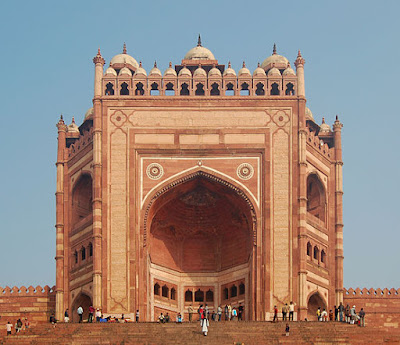The central porch contains 3 arched entrances, with the most important one, within the centre, is understood domestically because the Horseshoe Gate, when the custom of nailing horseshoes to its giant wood doors for luck. Outside the large steps of the Buland Darwaza to left is deep well.
Jama Masjid: it's a Jama masjid that means the congregational masjid and was maybe one in all the primary buildings to be created within the advanced, as its epigraph offers AH 979(A.D. 1571-72) because the date of its completion, with a colossal entrance to the yard, the Buland-Darwaza supplementary some 5 years later. it absolutely was in-built the style of Indian mosques, with iwans around a central yard. A characteristic feature is that the row of chhatri over the sanctuary. There area unit 3 mihrabs in every of the seven bays, whereas the massive central mihrab is roofed by a dome, it's adorned with white marble inlay, in geometric patterns.
Tomb of Salim Chishti: A white marble sheathed topographic point of the Sufi saint, Salim Chisti(1478–1572), among the Jama Masjid's sahn, courtyard. The single-storey structure is made around a central sq. chamber, among that is that the grave of the saint, below associate ornate picket cover covered with shell mosaic. encompassing it's a lined passageway for circumambulation, with sculpted Jalis, stone cut screens all around with tangled geometric style associated an entrance to the south. The topographic point is influenced by earlier mausolea of the first fifteenth century Gujarat land amount. different placing options of the topographic point area unit white marble snakelike brackets, that support sloping overhang round the parapet.
On the left of the topographic point, to the east, stands a red arenaceous rock topographic point of Islam Khan I, son of Shaikh Badruddin Chisti and grandchild of Shaikh Salim Chishti, WHO became a general within the Mughal army within the reign of Jahangir. The topographic point is screw-topped by a dome and 36 little vaulted chattris and contains variety of graves, some nameless, all male descendants of Shaikh Salim Chisti.
Diwan-i-Aam : Diwan-i-Aam or Hall of Public Audience, could be a building assortment found in several cities wherever the ruler meets the overall public. during this case, it's a pavilion-like multi-bayed rectangular structure fronting an oversized open house. South west of the Diwan-i-Am and next to the Turkic Sultana's House stand Turkic Baths.
Diwan-i-Khas: the Diwan-i-Khas or Hall of personal Audience, could be a plain sq. building with four chhatris on the roof. but it's noted for its central pillar, that incorporates a sq. base associated an polygon shaft, each sculpted with bands of geometric and floral styles, additional its 36 snakelike brackets support a circular platform for Akbar, that is connected to every corner of the building on the primary floor, by four stone walkways. it's here that Akbar had representatives of various religions discuss their faiths and gave non-public audience.
Ibadat Khana: (House of Worship) was a gathering house in-built 1575 metallic element by the Mughal Emperor Akbar, wherever the foundations of a replacement Syncretistic religion, Din-e-Ilahi were ordered by Akbar.
Anup Talao: Anup Talao was build by Raja Anup Singh Sikarwar A decorative pool with a central platform and 4 bridges leading up thereto. a number of the vital buildings of the royal territory area unit surround by it as well as, Khwabgah(House of Dreams) Akbar's residence, Panch Mahal, a five-storey palace, Diwan-i-Khas(Hall of personal Audience), Ankh Michauli and also the Astrologer's Seat, within the south-west corner of the board game Court.
Hujra-i-Anup Talao: same to be the residence of Akbar's Muslim partner, though this can be controversial because of its little size.
Mariam-uz-Zamani's Palace: The building of Akbar's Hindu wives, as well as Mariam-uz-Zamani, shows Gujarati influence and is made around a yard, with special care being taken to confirm privacy.
Naubat Khana: conjointly referred to as Naqqar Khana that means a drum house, wherever musician used drums to announce the arrival of the Emperor. it's located earlier than the Hathi politico Gate or the Elephant Gate, the south entrance to the advanced, suggesting that it absolutely was the imperial entrance.
Pachisi Court: A sq. marked out as an oversized parlour game, the precursor to modern-day board game game wherever folks served because the taking part in items.
Panch Mahal: A five-storied palatial structure, with the tiers step by step decreasing in size, until the ultimate one, that could be a single large-domed chhatri. Originally cut stone screens featured the facade and doubtless sub-divided the inside further, suggesting it absolutely was designed for the women of the court. The floors area unit supported by elaborately sculpted columns on every level, totalling to 176 columns all told.
Birbal's House: The house of Akbar's favorite minister, WHO was a Hindu. Notable options of the building area unit the horizontal sloping sunshades or chajjas and also the brackets that support them.



